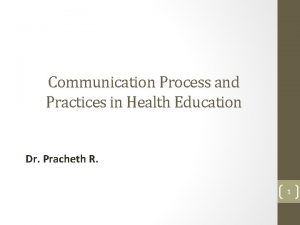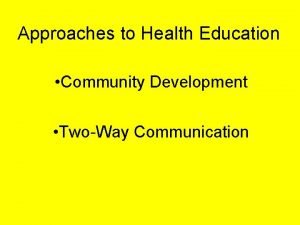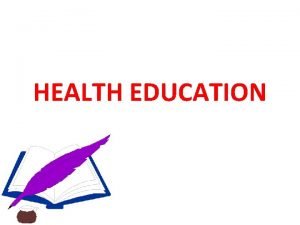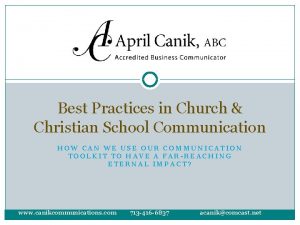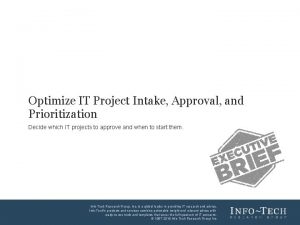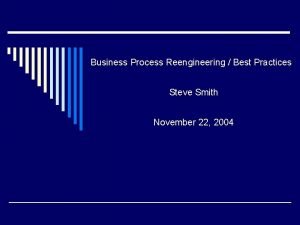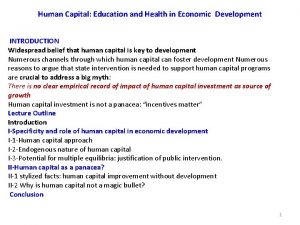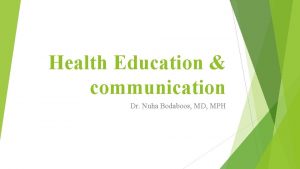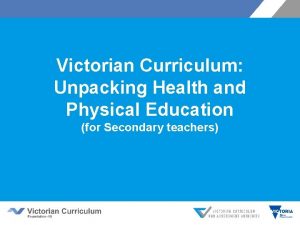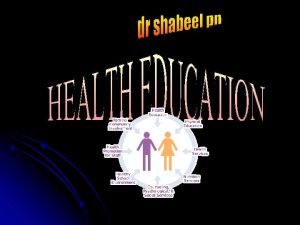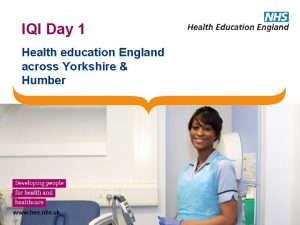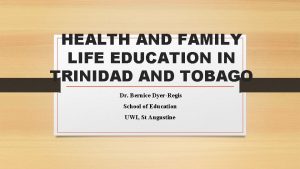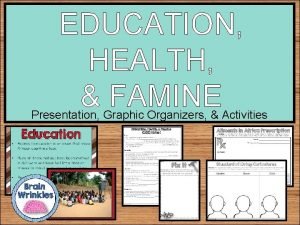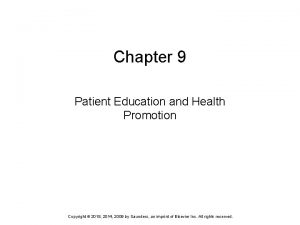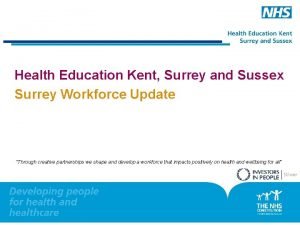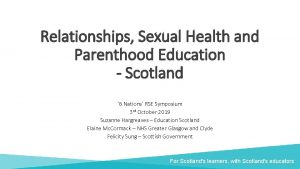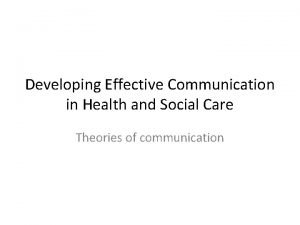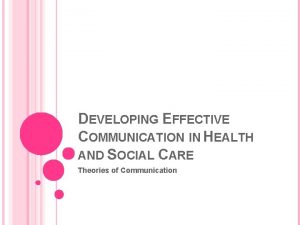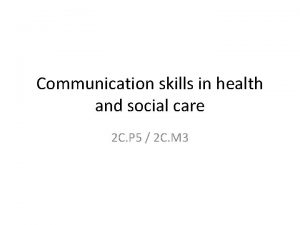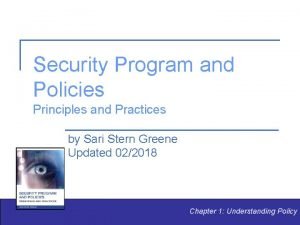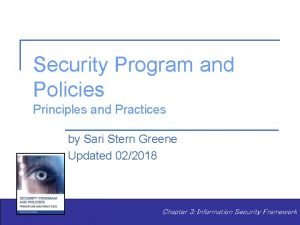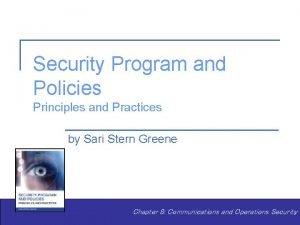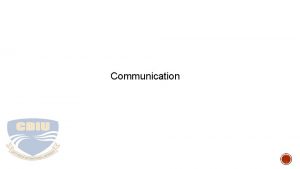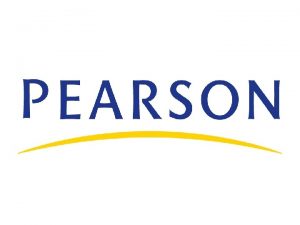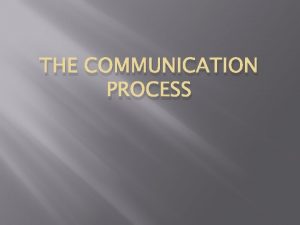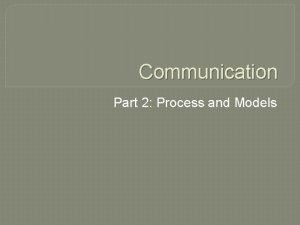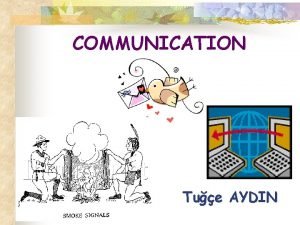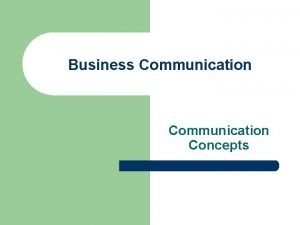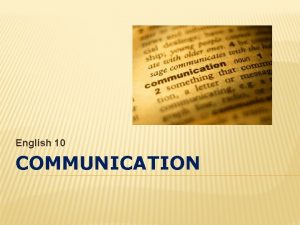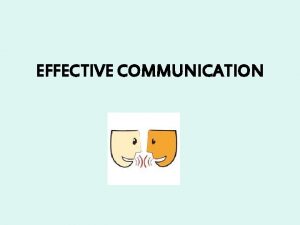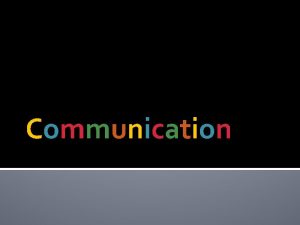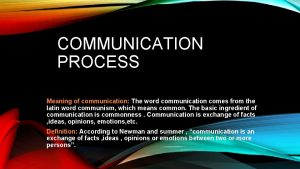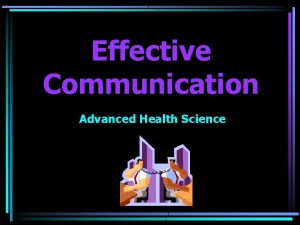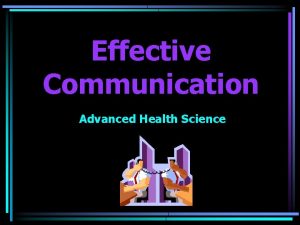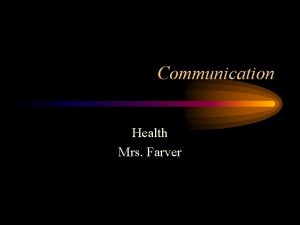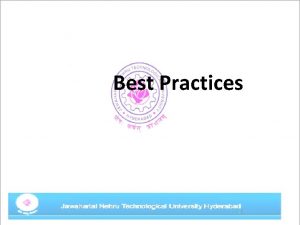Communication Process and Practices in Health Education Dr








































- Slides: 40

Communication Process and Practices in Health Education Dr. Pracheth R. 1

Outline • Definition • Approaches • Models • Principles • Communication process • Barriers • Methods 2

Health education • Definition • Objectives: üHealth promoting lifestyle and practices üUse health services üRational decisions üIndividual and community participation 3

Regulatory approach • Any governmental intervention • Designed to alter human behaviour. 4

Service approach • Tried by the basic health services in 1960’s. • Providing services at their doorsteps. • Conclusion: Health service should be based on their felt needs. 5

Health education approach • People should have autonomy over their own lives. • Informed people -decisions to protect his own health. 6

Primary health care approach • Starting from the people • Full participation • Active involvement in planning and delivery of health services 7

Models: Medical • Recognition, treatment of disease, advances • Disseminate health information: scientific facts • Social, cultural, psychological factors ignored 8

Motivation model • Main force: translate information-action • Three stages: üAwareness: interest üMotivation: evaluation, decision-making üAction: adoption/acceptance • New idea: part of existing values 9

Social intervention model • Health problems complex • Social environment • Understanding: cultural, biological, physical, social environmental factors • Strategies: all models • Only one method: failure 10

Principles • Credibility • Interest • Participation • Motivation • Comprehension • Reinforcement 11

Continued…. . • Learning by doing • Known to Unknown • Setting an example • Good human relations • Feedback • Leaders 12

Communication process 13

Qualities of a good message • Information which communicator transmits to audience to receive, understand • Form of pictures, words, signs 14

A good message • In line with objectives • Meaningful • Based on felt needs • Clear, understandable • Specific, accurate • Timely, adequate • Interesting • Culturally acceptable 15

Types of communication • One-way communication (Didactic Method) üLectures üKnowledge-imposed üLearning authoritative üLittle audience participation üNo feedback üLess likely : influence behaviour 16

Two-way communication (Socratic ) • Both communicator, audience take part • Raise questions, opinions • Active and democratic • More likely: influence behaviour 17

Continued…. • Verbal : Word of mouth, traditional method • Non-verbal: bodily movements, gestures, postures • Formal: in lines of authority • Informal: gossip circles, more active • Visual: charts, maps • Telecommunication, internet 18

Barriers of communication* • Physiological: hearing, expression • Psychological: emotional disturbances, language/comprehension difficulty • Environmental: noise, invisibility, congestion • Cultural: illiteracy, level of knowledge, understanding, customs, language variations. 19

Health education : aids/ methods • Audio-visual aids: üAuditory aids: radio, tape-recorder, microphones, amplifiers, earphones üVisual aids: Ø Not requiring projection: chalk-board, leaflets, posters, charts, flannelograph ØRequiring projection: slides, film strips üCombined A-V aids: television, sound films, slide-tape combination 20

Methods • Individual approach • Group approach • Mass approach 21

Individual approach • Personal interviews by a doctor • Educate , counsel patients • Take him/her: confidence • Patient listen readily • Persuade : change-behaviour • Opportunity: interact 22

Group approach • Chalk and talk (lecture): üCarefully prepared-presentation: facts, organized thoughts, ideas-qualified persons üChalk: visual component üSpeaker: legibility üGroup: not be more than 30 23

Continued…. . • Flipcharts • Flannelograph • Exhibits, models, specimens 24

25

26

Drawbacks • Students: involved minimum extent • Learning: passive • Not stimulate thinking/problem solving • Comprehension varies student-student 27

Demonstrations • Presentation: perform skill/procedure • Arouse interest • Learning by doing • Changes in behaviour • Demonstration of ORS • Clinical teaching 28

Group discussion • Aggregation of people in situation • Different from classrooms • Freely exchange ideas • Long term compliance: stop smoking • Not less than 6, not more than 12, circle • Recorder prepares report 29

30

31

Panel • 4 -8, sit, discuss problem, larger audience • Chairman/moderator • Spontaneous, natural • Extremely effective: guided, planned 32

Symposium • Series of speeches on selected subject • Each person : specific aspect • No discussion-speakers • Audience: questions 33

Workshop • Series of meeting • Individual work within group • Friendly atmosphere • Expert guidance 34

Role play • Dramatization • Enact roles as observed by them • Audience: suggest alternatives • Discussion of problems-human relationships 35

Conferences, seminars • Large component : commercialized continuing education • Held: regional, state, national level • Comprehensive/single topic in depth 36

Mass approach • One-way communication • Transmit messages: remotest places • Inadequate in changing behaviour 37

Methods in mass media • Television • Radio • Internet • Newspapers • Printed materials/pamphlets • Direct mailing • Posters, billboards • Folk media 38

Summary 39

THANKS 40
 Communication process in health education
Communication process in health education Difference between health education and physical education
Difference between health education and physical education Difference between health education and health propaganda
Difference between health education and health propaganda Two way communication health promotion
Two way communication health promotion Health education meaning
Health education meaning Maintenance of good health
Maintenance of good health Church communication best practices
Church communication best practices Pmo project intake process
Pmo project intake process Business process reengineering best practices
Business process reengineering best practices Health and social component 3
Health and social component 3 Is als a non formal education
Is als a non formal education Hpe curriculum vic
Hpe curriculum vic Human capital education and health in economic development
Human capital education and health in economic development Soil seed and sower in health education
Soil seed and sower in health education Victorian curriculum physical education
Victorian curriculum physical education Gcche
Gcche Instructing people
Instructing people Health education england yorkshire and humber
Health education england yorkshire and humber Hfle curriculum trinidad secondary
Hfle curriculum trinidad secondary Africa's economic systems comprehension check answer key
Africa's economic systems comprehension check answer key Patient readiness to learn
Patient readiness to learn What are the difference between guidance and counseling
What are the difference between guidance and counseling Health education kent surrey and sussex
Health education kent surrey and sussex Sexual health and relationships education scotland
Sexual health and relationships education scotland Georgia court system
Georgia court system Chapter 3 health wellness and health disparities
Chapter 3 health wellness and health disparities Glencoe health chapter 1 understanding health and wellness
Glencoe health chapter 1 understanding health and wellness Understanding health and wellness
Understanding health and wellness One to one communication in health and social care
One to one communication in health and social care Theories of communication in health and social care
Theories of communication in health and social care Observation skills in health and social care
Observation skills in health and social care What is oral communication and written communication
What is oral communication and written communication Difference between oral and written communication
Difference between oral and written communication Parallel communication examples
Parallel communication examples Security program and policies principles and practices
Security program and policies principles and practices Security program and policies principles and practices
Security program and policies principles and practices Security program and policies principles and practices
Security program and policies principles and practices Security program and policies principles and practices
Security program and policies principles and practices Security program and policies principles and practices
Security program and policies principles and practices The process of giving and receiving information
The process of giving and receiving information Technical communication: process and product
Technical communication: process and product
